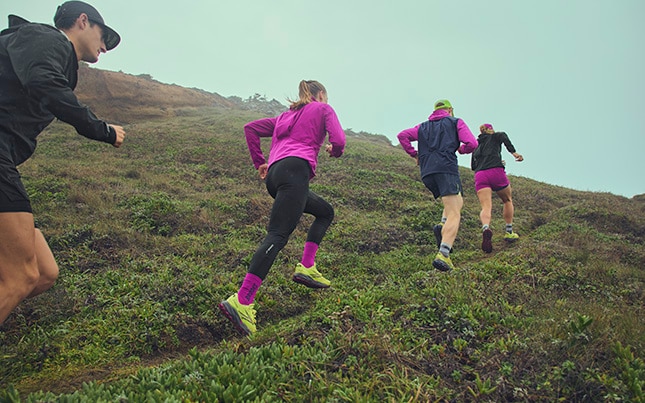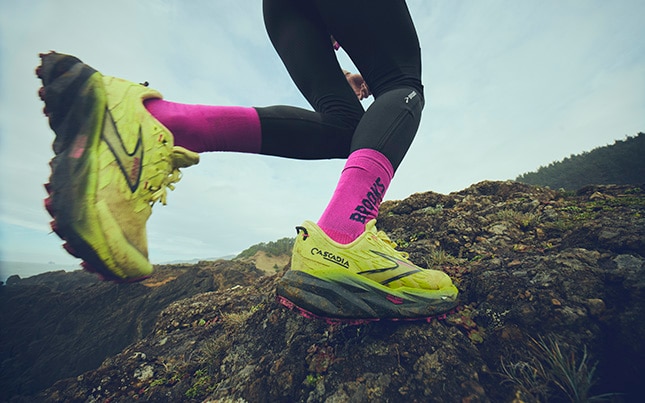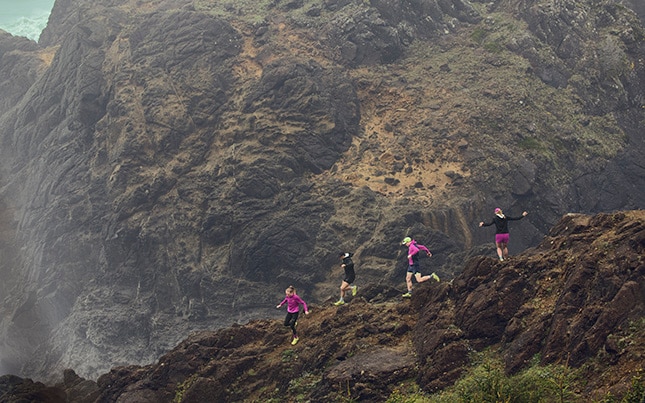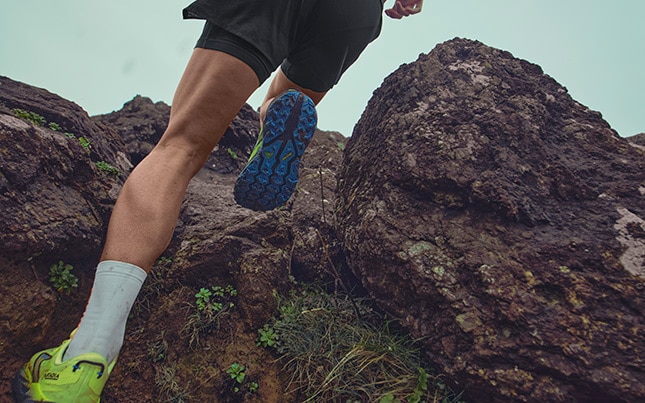Trail running tips for beginners

New to trail running and wondering how to get started? Our experts have advice on everything, from safety to technology and shoes.
What is trail running?
There’s a great big world out there beyond the pavement, and trail running is a wonderful way to experience it. It’s a simple enough concept—get out in nature and go running in it. You can find running trails in the mountains, city parks, on the coast, or really on any unpaved path. While the change in scenery from paved road to the great outdoors seems simple, there’s plenty to learn when you’re new to the scene.
We chatted with experienced Brooks employees about how to start trail running, including safety considerations, essential gear, and more. Read the tips they had about trail running for beginners.

Trail running safety tips
- If running alone on a trail, always tell someone where you are going and a rough time window of your run. Trails often have spotty or no cell reception. So it’s good common sense to let others know your plans.
- Read trail reviews in advance on hiking sites or apps like AllTrails. This can help you preview trail surface conditions and avoid surprises like closed trailheads or downed trees due to storms. Users contribute helpful details, so you can prepare for specific weather conditions, wildlife (both flora and fauna), and even permits and parking. These resources offer a general sense of how busy the trail is and if it meets your difficulty level. If you notice a trail hasn’t been reviewed in a long time, that may indicate an area to avoid.
- Take a picture or screenshot of the trail map, so you don’t have to rely on cell service.
- Be friendly to other trail users, and politely announce you’re passing from 10+ metres away. Making your presence known is a courtesy, but it’s also good safety—doing so can help you avoid potential conflict. After all, no one likes being snuck up on.
- Running on trails generally takes longer than running on roads, and sometimes you’ll be out for much longer than you expect. Having essentials like water and proper running gear helps ensure you’ll be safe, no matter the conditions.
Things to keep in mind for your trail run
- Respect the trail and the land it runs through. Remember, the land you are running on was likely inhabited by indigenous people for generations. Keep your litter to yourself, and leave the trail as you found it. Learning the history of the area you are running in will build an appreciation for its past and preserve its future use too.
- It’s OK to walk or hike during your trail run. Everyone does it at some point, even the runners up at the front of the pack—there’s no shame in slowing down on steep inclines or whenever you need a break. After all, why get out in nature if you don’t take time to enjoy it?
- Don’t compare your trail pace to your road pace. When you run trails you can easily add 2-plus minutes to your normal “go-to” comfortable pace. When you run on varied terrain, your pace is more of an average of your overall effort spent on climbs, downhills, and flat sections, not hitting precise splits for every kilometre.

- Stability and core exercise can help with agility, which comes in handy while trying to avoid roots, rocks, and puddles.
- Run with friends! New things are more fun and easier to get into when you have a buddy to share them with.
- If you’ve signed up for your first trail race, read race reports or try to find podcasts online to get advice beforehand on what to expect from the course and conditions.
- If you run with a GPS watch, you can often find .gpx files of trail-race courses to upload to your watch to make sure you are on the right path in real time. While trail-race courses are usually well marked, it’s normal to find yourself alone along the way, and it’s good to know you’re headed in the right direction.
What to bring trail running
- Do you need specific trail running shoes? Yes and no. If your trail is flat and dry, your road shoes should be fine for your run. But it’s not a bad idea to invest in good trail running shoes. They offer better traction and more protection from the elements (think slippery terrain and jagged rocks). Brooks has men’s trail running shoes and women’s trail shoes designed for the great outdoors.
- Water is essential for any run, but since trail running can take you far from the nearest water fountain, it’s best to make sure you’re well prepared with extra hydration. Consider a good hydration pack, which can come in the form of backpacks, vests, hip belts, or handheld bottles. Go to a local shop, and try them on in person to find out what suits you best.
- In addition to water, pack a small first aid kit, your cell phone, and easy-to-carry foods like energy bars.
- Dress in layers to keep from getting too hot or cold if the weather suddenly changes. Gear like neck gaiters, arm sleeves, and bandanas are versatile—they can protect you from the sun, prickly plants, and insects, and are easy to shed or tie to your pack. You can also dip these in water in a stream or stuff them with ice at aid stations to cool off.

Finding the best trail running shoes for beginners
If you’re new to running, you may need to start by finding suitable shoes. While personal preference is important, the best trail running shoes for beginners offer features like grip, stability, and protection, which are all vital for tackling uneven terrain. Look for shoes with aggressive lug patterns on the outsole for reliable traction, and reinforced toe caps to protect your feet from rocks and roots. If this is your first pair of trail runners, it can be helpful to check out a local running store to see what fits best, or check out our Shoe Finder for recommendations!
Build trail running stamina
Trail running, unlike road running, demands more varied muscle use and cardiovascular endurance. To build stamina for the trails, incorporate hill repeats into your training. Find a moderate incline, and run uphill for a set time, then walk or jog down to recover. You can learn more about the difference between stamina and endurance on our blog. Additionally, consider adding longer runs at a slower pace to increase your overall endurance. Remember, it’s okay to hike during your trail runs; listen to your body, and adjust your pace as needed. Building stamina is a lifelong process, and will build with more reps.
Enjoying the benefits of trail running in nature
Trail running offers a unique blend of physical challenge and mental rejuvenation. Exploring running benefits is a strong reason to get into trail running. Beyond the cardiovascular benefits, trail running offers a chance to connect with nature, reduce stress, and improve your overall well-being. Learn about what running does to your body and how to take it all in for your benefit. Remember, trail running isn’t just about the workout—it’s about experiencing something new. Don’t be afraid to walk or hike, and enjoy taking your time while you’re out in nature.
Now you know how to start trail running!
Trail running doesn’t have to be intimidating. Take it at your own pace, be safe, and enjoy the splendour of the great outdoors. Now that you have a good collection of trail running tips for beginners in your back pocket, boost your knowledge with more running tips, featuring pearls of wisdom that will help you get started if you are new to running in general. Enjoy the trail!
This is a carousel. Use next and Previous buttons to navigate.
Disclaimer: Our writer’s advice is intended for informational or general educational purposes only. We always encourage you to speak with your physician or healthcare provider before making any adjustments to your running, nutrition, or fitness routines.
